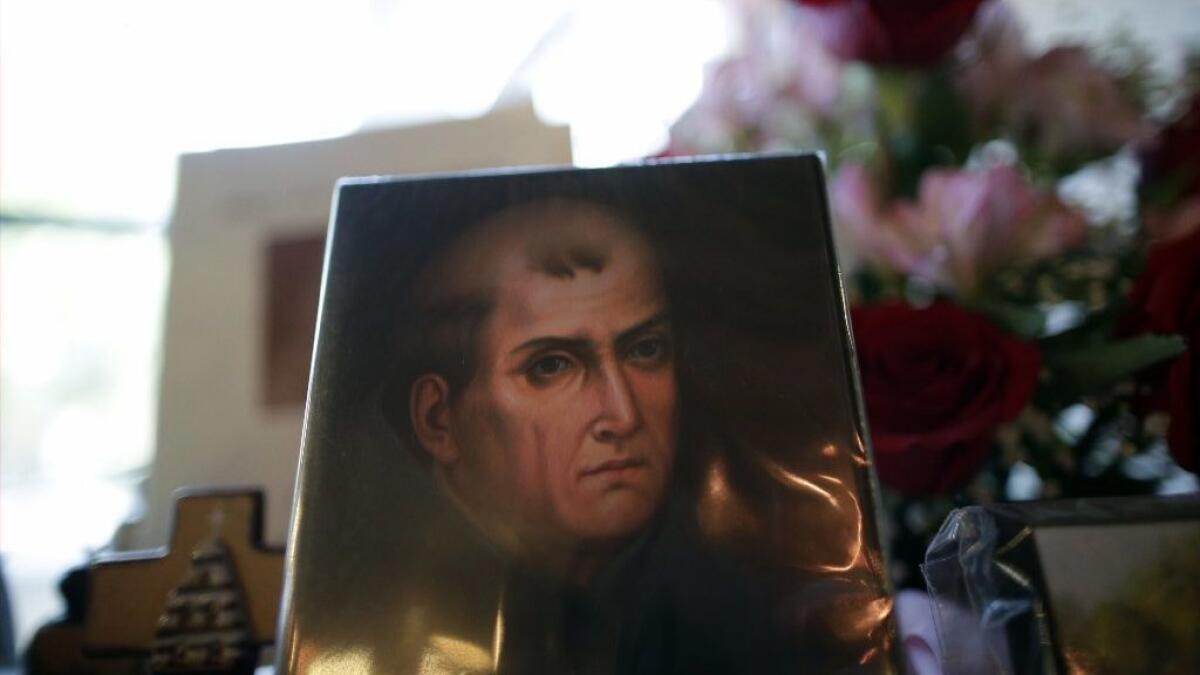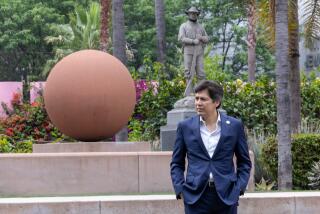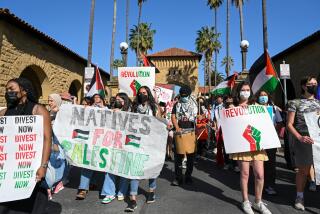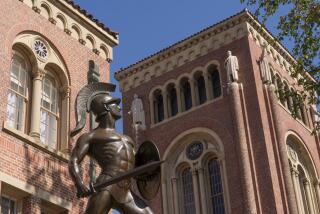Op-Ed: Removing Father Serra’s name from campus buildings is the easy part. To be truly inclusive, Stanford needs to do more

Father Junípero Serra may have been canonized by the pope in 2015, but soon thereafter his public reputation began to falter.
Statues of Serra, who founded the first California missions, have been vandalized in recent years, and there have been calls for his name to be removed from public places. This month, Stanford University announced that it will remove Serra’s name from not only the school’s main entrance and mailing address, but also two of its buildings.
The decision is a good one in many ways. It spares Native Americans and others on campus any distress they might experience from having to work, study or live in or near a space named after a man who brought great harm to California Indians. It is important that Stanford foster a campus environment that welcomes and nurtures diversity and multiculturalism.
But as a Stanford alum, an expert on Father Serra and California history, and a scholar who consulted with the original faculty committee that took up the question of removing Serra’s name from the campus, I cannot help but wonder about the scope of this decision, the contradictions inherent in the remedies it proposes, and what it says about our understanding of Serra and the missions.
I fear that Stanford’s decision is based on, and will perpetuate, a highly selective reading of recent scholarship on the California missions, and that it heralds the return of a discredited historical orthodoxy in which Serra is one-dimensional and California Indians are passive victims.
Stanford should redouble its efforts to examine its original sins.
The university stated in its announcement that the missions’ treatment of Indians “has come under increasing scrutiny” in recent years, and that a “reevaluation of Serra’s legacy has focused on the harmful and violent impacts of the mission system on Native Americans.” These criticisms are well founded. But while they may be new to Stanford’s administrators, they are as old as the missions themselves.
A preponderance of recent scholarship has told a more nuanced and balanced story. It has focused not only on the destructive power of the missions but also on the fortitude and resilience shown by Indians who lived in them. Faced with a colonial invasion in which foreign plants and animals and settlers overran their lands and imperiled their subsistence, many Indians looked to the missions as places where they and their families might survive.
Recent scholarship has also revealed that men like Serra could not have built and run missions without the help of Native Americans. No doubt Indians’ labor was coerced, sometimes by soldiers, sometimes by padres, and sometimes by Indians in their employ. And yes, the threat of Spanish violence was everywhere. But to see men like Serra as all powerful is to deny the degree to which Indians not only resisted the missions but also, in one way or another, under horrific conditions, played a vital role in the religious and economic worlds that emerged there as they navigated the challenges of colonialism and sought to make the missions their own.
Serra’s chapter of California history continued a colonization process that began centuries earlier. Countless other leading missionaries from Spain — as well as royal officials, governors and military officials — either preceded Serra or came with him and made colonization possible. Many of these men have a street or way named after them on the Stanford campus, yet not one of those places has been singled out for renaming.
Clearly aware of this glaring inconsistency, the committee stated that “absent the discovery of major new evidence about a particular individual’s misconduct, these other named features should not be subject to renaming.” Surely a quick trip to Stanford’s extensive library collections would yield a mountain of evidence that these other men are guilty of deeds similar to, if not worse than, Serra’s.
Enter the Fray: First takes on the news of the minute from L.A. Times Opinion »
The school’s decision to rename Serra Way after Jane Stanford, the co-founder of the university, is at first glance appealing. But on closer inspection it may prove counterproductive and insensitive. Jane Stanford’s unilateral decision to cap the university’s female enrollment at 500 students was a blot on the institution and a real setback for women, the institution and coeducation.
Moreover, few persons of means were more attached to the promotion of a highly sympathetic understanding of Serra than Jane Stanford. She frequented Mission Carmel where Serra is buried, helped restore it and funded a granite monument honoring Serra’s arrival in Monterey. It was the first such monument dedicated to Serra, and it contributed greatly to his rising fame and notoriety.
Stanford seems committed to scaling back Serra’s presence on its campus. But the university’s administrators should do more. They should remove the names of the other Spanish colonists from the campus, as well as Serra’s, from all its streets.
Stanford should also redouble its efforts to examine its original sins, namely the degree to which the Stanford fortune was gained through the exploitation of Chinese laborers and the ways in which, as California’s governor and a U.S. senator, Leland Stanford tolerated or was complicit in policies that directly harmed Native Americans in California and elsewhere.
The issue of street and building names will ultimately fade and be replaced by timelier causes. The true measure of Stanford’s inclusivity will be found in the diversity of its faculty, students and course offerings. In this sense, too, more needs to be done.
Steven W. Hackel is a professor of history at UC Riverside and the author of three books, including “Junipero Serra: California’s Founding Father.”
Follow the Opinion section on Twitter @latimesopinion or Facebook
More to Read
A cure for the common opinion
Get thought-provoking perspectives with our weekly newsletter.
You may occasionally receive promotional content from the Los Angeles Times.










